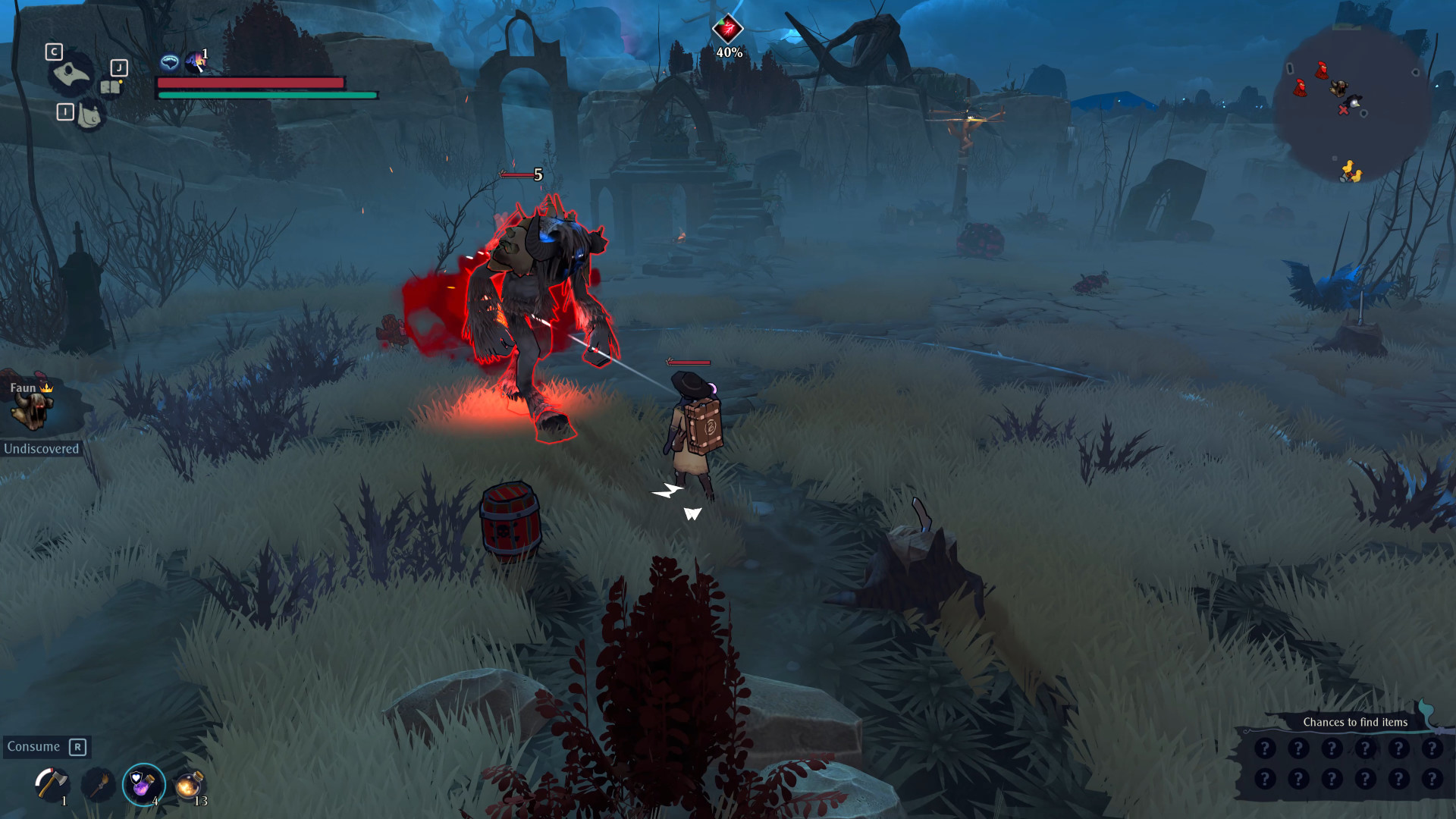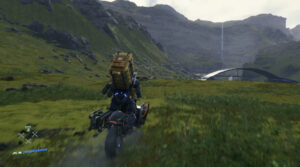For those of us that prefer a hands-off approach to our roguelike and/or sandbox games and just want thrown into the thick of things, The Serpent Rogue might be just what the doctor ordered. Playing as the warden, the player has quite a bit of control over how they approach this corrupted world’s many issues. The game gives you enough agency in fact, that it can sometimes be a little off-putting, especially at first. This will undoubtedly make or break the experience for you depending on how much you enjoy finding out how a game works from scratch, but either way it does provide some compelling hooks that are mostly effective at keeping the player engaged for at least a little while. Some light combat, a ton of resource management, alchemy, and an open-ended sandbox make up this low-key adventure.
“The graphics are mostly pretty simple and flat, which might seem like it would be at odds with the darker tone of the game’s atmosphere but it’s really not. The washed-out colors and understated effects create an interesting vibe despite coming off decidedly low-budget a lot of the time.”
With a visual tone that might not seem like much at first, there’s actually quite a lot of effective world building here. Mount Morbus is a dreary place full of gloom and danger. Fog swallows much of it, keeping your view limited to the area you currently occupy. Plus, there’s the corruption that ultimately needs to be cleared in whatever way seems best to you. The graphics are mostly pretty simple and flat, which might seem like it would be at odds with the darker tone of the game’s atmosphere but it’s really not. The washed-out colors and understated effects create an interesting vibe despite coming off decidedly low-budget a lot of the time.
As your guide Solomon warns you, your initial steps will indeed be the hardest. This translates pretty well to the fact that the game throws you to the wolves for the most part after this introductory segment. Crafting, melding, resource farming, item management and the world’s various side quests just sort of present themselves and expect you to figure them out. Thankfully, if you’ve ever played a game that contains these elements then their basic structure will come pretty naturally to you, but a somewhat redundant assortment of menus that aren’t particularly intuitive do make the process a little more arduous than it needs to be.
This hands-off approach continues as the game’s many side activities and main questline issues present themselves, and though it clearly wants you to feel like you’re in an open-ended situation, most of the game’s challenges ultimately only have one or two ways to overcome them so its openness can feel a little superficial at times. With that, it becomes more about discovering what those methods of advancement are rather than discovering your own way forward. Even still, the uphill climb of experimenting with different solutions and systems to get the results you want is surprisingly addicting at times. As you stumble across items, creatures, and various ingredients and thus get access to different potions and actions, your experimentation is often rewarded with anything from a great dish to an effective weapon. Turning into a wolf to blaze past certain enemies or be more effective in attacking other ones, discovering helpful recipes out in the wild that you can then use to make a weapon or a dish, and other multi-step milestones you cross give you just enough of a dopamine hit to want to keep venturing further into the world and seeing what’s next.
“This hands-off approach continues as the game’s many side activities and main questline issues present themselves, and though it clearly wants you to feel like you’re in an open-ended situation, most of the game’s challenges ultimately only have one or two ways to overcome them so its openness can feel a little superficial at times.”
With experimentation tends to come a series of failures though and The Serpent Rogue is certainly beholden to that. You often die even when you’re not necessarily trying to take a risk. Early on this can create some frustration as a status ailment eats your health away that the game has not warned you about nor given you any clear solution to. This causes you to frantically look around in your several inventory management screens to see if you have anything that looks like a solution before certain death. Also, weak enemies are often mixed in with extremely powerful ones, giving you even less of an on-ramp to the game’s many challenges. Certain players might like this sort of thing, but I felt like it mostly distracted from an otherwise well-crafted system of mechanics. In any case, said deaths will result in you losing everything in your inventory but with a single chance to get it all back if you can return to the area of death before dying again.
If you die again before you get to them then they’re gone forever. Dying in a dangerous area of course creates a situation where you’re even less likely to survive it on your way to your items, but if you manage your resources well you should have backups stashed in a safe area. If not, then you’re doomed. Plus, the occasional corruption storm will also end up ravaging the game’s more tumultuous areas creating an extremely dangerous situation for you if you get caught in it. If you’re very far from an exit this could spell certain doom. Once again, I feel like this will be a divisive element to most players, as people tend to either really like this sort of difficulty or really hate it. Either way, while it’s not really my favorite thing, nor is it implemented particularly well here, it does work for what it’s trying to do and I can certainly respect the game’s dedication to this approach.
Other peripheral activities like taming wild animals, learning alchemy recipes, discovering chests full of important resources and more also await you to pursue them as you see fit, but of course the more you are able to learn early on the better you will do when big problems inevitably show up. Some of these things the game explains to you better than others though, as discovering different recipes for potions or dishes seemed more or less up to blind luck for me, while other things like finding an ax to chop down trees and get wood were far more telegraphed.
“The Serpent Rogue succeeds in making a challenging game that leaves enough things unexplained to feel like a constant mystery, but I can definitely see it struggling to hold the attention of most gamers past those few introductory hours.”
The Serpent Rogue succeeds in making a challenging game that leaves enough things unexplained to feel like a constant mystery, but I can definitely see it struggling to hold the attention of most gamers past those few introductory hours. If you really like survival games and/or chipping away at understanding a game’s mechanics on your own, I think it might fit very well into your library. Sadly, I don’t think it does nearly enough to cater to very many other sensibilities than that. The combat and crafting aren’t particularly fun, the story isn’t particularly engrossing, and despite some moderately addicting loops here and there the progression oscillates a bit too much between being decent and dragging its feet.
This game was reviewed on the PlayStation 5.
- About
- access
- across
- activities
- Advancement
- Adventure
- Agency
- Alchemy
- All
- animals
- Anything
- approach
- arduous
- AREA
- around
- Atmosphere
- backups
- before
- BEST
- Better
- Bit
- Building
- case
- caught
- challenges
- challenging
- coming
- compelling
- continues
- Corruption
- could
- crafting
- create
- Creating
- despite
- different
- Doctor
- Doom
- down
- Early
- Effective
- elements
- Exit
- experience
- farming
- favorite
- Feet
- Figure
- First
- fit
- Forward
- full
- fun
- further
- game
- Gamers
- Games
- given
- Giving
- graphics
- great
- guide
- Health
- here
- hold
- How
- HTTPS
- i
- implemented
- important
- inventory
- inventory management
- issues
- IT
- keeping
- LEARN
- learning
- Library
- light
- Limited
- Luck
- Making
- manage
- management
- Mechanics
- Milestones
- mixed
- more
- Mystery
- Odds
- open-ended
- Other
- own
- People
- player
- players
- Playing
- playstation
- playstation 5
- Plus
- powerful
- present
- Process
- Provide
- quests
- Recipes
- resource
- Resources
- Results
- review
- Risk
- s
- safe
- Said
- sandbox
- Series
- Short
- Simple
- So
- solution
- Solutions
- Status
- Storm
- Story
- survive
- system
- Systems
- The
- the world
- time
- Ton
- trees
- us
- View
- What
- Wolf
- wolves
- Work
- works
- world
- youtube













